
We don't know for sure what day Ludwig van Beethoven was born, but it is documented that he was baptized on December 17, 1770. Like practically everything about his fascinating life, this has been studied in detail and speculated over. Some folks say that he was probably baptized the day after he was born, and they thus insist that he was born on December 16. Whatever. What is not disputed, even by those who don't like his music (John Cage and Glenn Gould are two examples of great musicians who considered Beethoven's influence malignant), is that Beethoven was one of the most revolutionary and influential composers in history.
By expanding the range of acceptable harmonies and the breadth of musical forms, he spurred the shift from the Classical style to the Romantic era. With his mighty symphonic works he also made high-art music a matter not just for the entertainment of the wealthy and privileged but also the enlightenment of the masses. Most of all, he made music more than light entertainment, and redefined the idea of musical beauty, by deeply imbuing his works with his own personality to a degree unapproached before then but often held up as a model ever since. Not only were many subsequent composers in awe of Beethoven's powers, his music became such an integral part of Western culture that even people who know practically nothing about classical music can recognize the "da-da-da dum" opening of his Fifth Symphony. His Ninth Symphony, which innovatively culminates in a choral setting of Schiller's poem "Ode to Joy," is such a symbol of human brotherhood that it was programmed to celebrate the fall of the Berlin Wall.
Born into a working class home, with his father's alcoholism requiring that Beethoven support his family, the prodigy composer was an excellent pianist and violinist who also played organ and horn. He was able to study with Franz Joseph Haydn, Johann Georg Albrechtsberger, and Antonio Salieri, and made his Vienna debut in 1795 as piano soloist in one of his own concertos, in an era when composers were almost always performers and, often, vice versa. But just as he was becoming popular and well-known, in 1802 he noticed that he was losing his hearing. Yet this indomitable man continued to attain greater and more innovative heights of self-expression.
More than any of his other works, it was Beethoven's nine symphonies that came to symbolize his transformation of music into public utterance for the masses. He expanded symphonic form greatly starting with his Third Symphony, the "Eroica," an urge which culminated in the Ninth, the "Choral," with chorus and vocal soloists. The "Eroica" also was programmatic (something Haydn had occasionally done), and that impulse reached new heights of specificity in the Sixth, named the "Pastoral." No other composer's work has been as extensively recorded as Beethoven's symphonies. Sorting out the most recommendable recordings thus proves both more necessary and more daunting. Respecting a variety of interpretive approaches, the following recommendations abandon pretenses of definitiveness and merely hope to be useful. First come complete sets, followed by a few outstanding performances of individual symphonies.
CYCLES
No Beethoven symphony cycles are perfect. The music is so multi-faceted that not only can no single performance of a given symphony bring out all of the qualities that can be found in the work, no conductor's approach is ideally suited to all of these very different works. Here are my favorites among several main approaches.
Energy
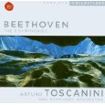 Eileen Farrell, Nan Merriman, Jan Peerce, Norman Scott/Robert Shaw Chorale/NBC Symphony Orchestra/Arturo Toscanini (RCA) 9/Missa Solemnis
Eileen Farrell, Nan Merriman, Jan Peerce, Norman Scott/Robert Shaw Chorale/NBC Symphony Orchestra/Arturo Toscanini (RCA) 9/Missa Solemnis
These 1949-52 recordings, taped in live performance for broadcast, were issued as a set by RCA soon after the introduction of the LP. They have been controversial classics ever since. Yet though Toscanini's fast tempos in Beethoven were decried by some, he was closer to the metronome indications than most other conductors at the time, anticipating the “period performance” movement.
Toscanini's swift tempos preserve the First's Classical feel well. Grace and elegance are not often attributed to this conductor, but they are here in abundance, though mixed with power and drive. Because of the symphony's smaller dimensions, Toscanini takes the exposition repeat in the first movement, which he does not do in the Second. In the latter, his Allegro con brio after the slower introduction zips along at a very brisk pace; the amazing precision of the strings and winds in the many 64th-note runs truly dazzes at this speed. Though he takes the beautiful main theme of the following Larghetto at a faster speed than many conductors, it sounds natural and unforced.
In the "Eroica," which inaugurated Beethoven's move into the Romantic period, Toscanini's 1949 recording competes with another, from a decade earlier but also with the NBC Symphony. The orchestra -- its style including more portamento at that point -- plays with deeper feeling in the 1939 version. The younger Toscanini's reading also gives the work more breadth, to small degrees in I and III and by nearly a minute in II, the famous Funeral March (in a heart-wrenching reading), and blazes through the finale in bravura fashion. There's plenty of character in both dashingly heroic readings. The Fourth's return to more of a Classical impulse elicits some supremely elegant -- even charming -- playing, with finely gradated dynamics paying big dividends. Toscanini's Fifth is lithely powerful, but the flat sound can't handle dynamic climaxes. No matter. You could listen to this Fifth through paper cups and a string and it would still be moving. It moves briskly throughout, but never sounds rushed, because Toscanini's tempos are varied and flexible.
Toscanini's tempos in the "Pastoral" Symphony (he said, "Germans play everything too slow") seem less startling nowadays than they did over five decades ago. And Toscanini allows this music to emerge in a more relaxed state than elsewhere in the cycle. He sounds happy to be in the country, his brook really burbles, his peasants sound truly merry, and if the recording equipment could have handled the peak volumes, we'd have the storm to end all storms. And when his shepherds rejoice, they don't seem stunned and comatose from the storm. The mysterious stirrings at the start of Seventh mix with the subsequent loping rhythms in complementary contrast, building to multiple climaxes that really pack a punch even with the top dynamics flattened by the recording. His Allegretto moves more quickly than most, with a hushed excitement of anticipation rather than mournful solemnity. Predictably, his Presto really is Presto, but the precision of the NBC Symphony is such that no details are blurred. And nobody has ever played the Allegro con brio with more brio. Beethoven's Eighth took the drama of his Romantic works and condensed them into Classical conciseness. Perhaps because of its Classical tilt, he takes the exposition repeat in the first movement. His approach works well in the small inner movements, where he imbues them with a graceful lilt. And as expected, his Allegro vivace finale gallops along at an exciting clip.
The Ninth is like a symphony with a short (interrupted) finale followed by a coda as long as any of its single movements. It starts in stark terror (I), proceeds into a life-and-death struggle (II) -- both of which Toscanini portrays better than any other conductor -- and ends in overwhelming joy. The third movement offers an unexplained but welcome relief from the struggle, which is then resumed at the opening of IV's alternation of uncertainty and a barely glimpsed heaven. It's when the unprecedented vocals appear in the until-then purely instrumental world of the symphony that joy begins its triumphal dispelling of doubt. By moving rapidly, but not at any sacrifice of emotion, through the twists and turns of this massive work, Toscanini holds together a structure which often threatens to fall apart into unconnected pieces. The incredible discipline of the NBC Symphony and the Robert Shaw Chorale are integral to the success of the performance. The solo quartet of soprano Eileen Farrell, mezzo Nan Merriman, tenor Jan Peerce, and bass Norman Scott also distinguishes itself, though Scott could be improved on and Farrell's terminal vibrato is a bit distracting at times.
Profundity 
Vienna Philharmonic, Stockholm Philharmonic, Choir & Orchestra of the Bayreuth Festival/Wilhelm Furtwängler (EMI Classics) 1 & 3, 5 & 7, 6 & 8, 9
The most significant feature of Furtwängler's conducting is how he treats phrasing in an extremely flexible and expressive manner without compromising -- in fact, enhancing -- the structural integrity of the music. Some will find his tempos slow, but he is able to maintain overall tension of the lines; the sense is of time being elongated, not of dragging or bogging down. And he was hardly committed to slow tempos as an overarching philosophy; in fast movements he could move with great alacrity. He was also a masterful manipulator of orchestral color. Time and again, Furtwängler, a composer himself, enters into these classic works and points out features other conductors zip past. He imbues the performances with spontaneity and a life-force that elevates them to transformative events.
His only complete cycle on record is this EMI set, made complete by incorporating concert performances of the Second and Eighth that were not recorded by EMI (and have dimmer sound). The 2000 remastering is superior to the cycle's 1980s incarnation, which in the quest for clean sonics scrubbed away some of the unique patina of the Vienna Phil. The Third, Fifth, Seventh, and Ninth receive some of their noblest readings ever. The Ninth is particularly famous, as this concert performance reopened Bayreuth following its shut-down in the wake of World War II; there is even more of a spiritual aura about it than in most of Furtwängler's performances (and, despite its concert provenance, the sound is quite good). With a largely excellent solo quartet and the fine Bayreuth chorus, even the often problematic finale positively glows. Aside from the Second, Eighth, and Ninth, these are studio recordings with the Vienna Philharmonic in its own hall, the Musikvereinssaal. 
Some critics feel Furtwängler's best performances tended to come with "his" orchestra, the Berlin Philharmonic, and that his concerts are more exciting than his studio work. The former assertion is highly debatable, but there's some truth to the latter, so as a supplement to the EMI set, look for the superb four-CD Music & Arts set from 1999. While not including all the symphonies, it is interesting for focusing on passionate recordings made during World War II in which the conductor (whose anti-Nazi bona fides are historically established) seemingly attempts to exorcise through art the myriad evils, fears, and frustrations faced by him and most Germans. This "Eroica" (also with the Vienna Phil) is characterized by bold momentum. The Fourth and Fifth, both with the Berlin Philharmonic, are weighter and more dramatic readings than his later versions. The unique March 1942 Ninth exudes a desperate search for affirmation; its power and catharsis are unmatched. Also included are the "Pastoral" and the Coriolan and Leonore No. 3 overtures.
Luba Orgonasova, Anne Sofie von Otter, Anthony Rolfe Johnson, Gilles Cachemaille/Orchestre Révolutionnaire et Romantique/John Eliot Gardiner (Archiv)
As I wrote of these 1991-94 recordings a decade ago for an out-of-print guide, "This is the original-instrument version of the symphonies for people who usually find original-instrument recordings too lightweight for Beethoven. Balances are not tilted too strongly away from the strings, though certainly the winds come through nicely with pungent but not vulgar tone. Tempos are often quick, but never degenerate into a scramble. The Fifth is winningly headstrong, the Seventh aptly dance-like yet also firm and weighty. In the Ninth, all but radical period-performance advocates will probably find Gardiner's speed in the Adagio not, in fact, an Adagio but rather an Andante (and a quick one, at that). However, overall this is quite an effective interpretation, and the soloists are better than usual in period groups. Bass Gilles Cachemaille is more expressive in his first solo than most of the competition, if not quite as imposing in tone. The solo quartet…is well matched and handles Gardiner's breakneck (but exciting and effective) finale tempos with impressive accuracy, as does the chorus and, for that matter, the orchestra."
Beauty 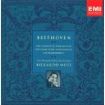
Cheryl Studer, Delores Ziegler, Peter Seiffert, and James Morris/Westminster Choir/Philadelphia Orchestra/Riccardo Muti (EMI Classics)
The predominant characteristic of Muti's cycle is overflowing joy (especially in the Seventh), and it's also one of the very best played and recorded cycles. The sheen of the Philadelphians may not be to everyone's taste, but it is unmatched. There are sets of this cycle with more vividly defined character, but for a budget-priced digital set (in which every performance is commendable and lacking in controversial points, Muti's 1985-88 cycle can't be beat. That description should not be taken as an indication that Muti's direction leads to bland, generic music-making, however, as it's often lively, leaping out of the box with the Fifth and not stumbling even in the often-problematic Ninth, which has a fine solo quartet. Besides the symphonies, this box set includes the Leonore Overture No. 3, the Fidelio Overture, and the Consecration of the House Overture. 
Helena Junten, Katarina Karnéus, Daniel Norman, Neal Davies/Minnesota Chorale/Minnesota Orchestra/Osmo Vänskä (Bis)
The newest recommendation offers both the most modern sonics and the most authoritative text. Though the soloists in the Ninth are more operatic than I like, this is nonetheless arguably the best cycle so far that uses Norman Del Mar's painstakingly researched and corrected editions. Vänskä generally finds the middle ground between period stylists' Haydnesque briskness and traditional grandiosity. Acute attention to specifics of phrasing and dynamic contrasts guide his undemonstrative interpretive style. When apt he's quite emphatic, accenting in a lean and limber way. Tempos are often fast, but not always as fast as they seem; the propulsiveness of some movements is largely due to his highly articulated way with rhythm. Every moment is keenly yet subtly characterized, made more vivid through clarity of sonics and clarity of performance. Lyricism is not lacking, highlighted by legato passages made more special by contrast -- legato is not Vänskä's default phrasing. He achieves distinctive without resorting to eccentricities.
INDIVIDUAL WORKS
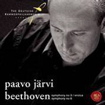 Symphonies Nos. 3 "Eroica" & 8: Deutsche Kammerphilharmonie Bremen/Paavo Järvi (RCA Red Seal)
Symphonies Nos. 3 "Eroica" & 8: Deutsche Kammerphilharmonie Bremen/Paavo Järvi (RCA Red Seal)
The most viscerally exciting of all Eroicas. Even ignoring its advantage of excellent SACD sound, it trumps such thrilling worthies as Toscanini and Bernstein. Though using a modern-instrument group, Järvi delivers a period-performance-informed interpretation bursting with rhythmic energy and keen clarity. The Eighth has much of the same character and is fine on those terms, though my personal taste is for a bit more charm and humor.
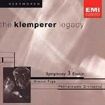 Symphony No. 3 in E-flat major, Op. 55 "Eroica": Philharmonia Orchestra/Otto Klemperer (EMI Classics)
Symphony No. 3 in E-flat major, Op. 55 "Eroica": Philharmonia Orchestra/Otto Klemperer (EMI Classics)
The polar opposite of Järvi's. Klemperer’s stolidly granitic Beethoven cycle would have aged better if the Philharmonia had been a better orchestra in the 1950s when he recorded it. Fortunately they’d improved by 1959, when this Eroica was recorded; it’s the set's high point. (Don’t mistake it for his 1955 mono recording, quicker but with scrappier playing.) Klemperer's tempi depict a poised and deliberate hero and provide pathos in the Funeral March. The horns sound wonderful in the Trio of the Scherzo. (Filling out the disc is a strings-only orchestration of the Grosse Fuge -- Great Fugue, originally for string quartet).
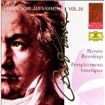 Symphonies Nos. 5 in C minor, Op. 67; 7 in A major, Op. 92: Berlin Philharmonic/Arthur Nikisch, Ferenc Fricsay (Deutsche Grammophon)
Symphonies Nos. 5 in C minor, Op. 67; 7 in A major, Op. 92: Berlin Philharmonic/Arthur Nikisch, Ferenc Fricsay (Deutsche Grammophon)
Volume 20 in Deutsche Grammophon's Complete Beethoven Edition, Historic Recordings, varies wildly -- in interpretive quality, in style, in sound -- but as far as its symphonies go, these are fairly crucial. Nikisch conducting the Fifth in 1913 (the first complete symphony recording in history) overcomes extremely low fidelity and the exigencies of early acoustic recording to deliver a thrilling account in ultra-Romantic style. Back when the musicians had to play into a big recording horn, not only was the size of the orchestra reduced to fit them within its capturing range, reorchestration was required because low-pitched stringed instruments were picked up very poorly by the recording horn, and their lines sometimes had to be reinforced by wind instruments. So the timbres are often surprising, but that's incidental; what's important here is the documentation of a 19th century style of conducting, with wildly fluctuating tempi and heavily inflected phrasing and dynamics that's much freer than we are used to nowadays (though not the quirk-fest that modernists such as Toscanini deprecated the old style as). And how sweetly and rapturously the violins phrase!
Leaping ahead in time to 1960, we get the underrated Fricsay's superb Seventh, envisioned on an imposingly monumental scale but allied with felicitously graceful playing and refulgent timbres. Also noteworthy, though not essential, is Carl Schuricht's 1941 Eroica, which both recalls the broad architecture of his much-praised Bruckner conducting and phrases with singing lyricism. But even DG's own liner notes call Fritz Busch's 1950 Ninth "brightly competent, without being particularly searching or in any way original." These are the only symphonies in this six-CD set, but there is much else (including Fricsay accompanying Annie Fischer in a must-hear Piano Concerto No. 3) that makes it a worthwhile investment. 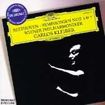
Symphonies Nos. 5 & 7: Vienna Philharmonic/Carlos Kleiber (Deutsche Grammophon)
These mid-'70s recordings are considered by many to be the best of these works, even more exciting than Toscanini's renditions. Sonically they place the burnished Vienna sound within a great sense of space. These are generally quite quick readings, even aggressive, but perfectly proportioned and never merely rushed or breathless. The engineering is as good as DG ever gave, and the playing is perfect.
Symphony No. 6 "Pastoral": Vienna Philharmonic/Karl Böhm (Deutsche Grammophon)
This is traditionally seen as an amiable, rustic work, but that interpretation is actually fairly difficult to bring off successfully. In this view most movements should convey a genial air, but the storm in the Allegro should be highly dramatic; most conductors get one or the other right, but not both. The underrated Böhm's long-praised performance is the exception.
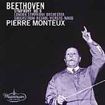 Symphony No. 9 "Choral": London Bach Choir/London Symphony Orchestra/Pierre Monteux (Westminster/Universal)
Symphony No. 9 "Choral": London Bach Choir/London Symphony Orchestra/Pierre Monteux (Westminster/Universal)
This Ninth is fleetly taut without being overdriven or unsmiling. The first two movements are noticeably brisk in an exciting but not overstated or thrill-seeking fashion. Even the following Adagio molto e cantabile moves along with alacrity; while this may not be to all tastes, it has an attractive dance-like lilt. The finale, though appropriately bustling at the beginning and building to a stirring conclusion, has very flexible tempos full of contrasts, with Monteux indulging the friendly collegiality of what is, after all, a glorified drinking song. He's got one of the most successful and well-balanced solo quartets ever recorded in this work: soprano Elisabeth Söderström, contralto Regina Resnik, tenor Jon Vickers (near the beginning of his glorious career), and bass David Ward. One even imagines that at times Monteux relaxes the music's progress to revel in their tones, though certainly the music-making never becomes slack on that account.
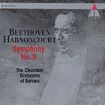 Symphony No. 9 "Choral": Charlotte Margiono, Birgit Remmert, Rudolf Schasching, Robert Holl/Arnold Schoenberg Choir/Chamber Orchestra of Europe/Nikolaus Harnoncourt (Teldec)
Symphony No. 9 "Choral": Charlotte Margiono, Birgit Remmert, Rudolf Schasching, Robert Holl/Arnold Schoenberg Choir/Chamber Orchestra of Europe/Nikolaus Harnoncourt (Teldec)
Harnoncourt made his reputation in Baroque music as one of the pioneers of period-instrument performance, but doesn't consider use of period instruments useful for music later than Mozart's. But despite the Chamber Orchestra of Europe's use of modern instruments, Harnoncourt's period-performance background is strongly reflected here (and in his entire estimable Beethoven cycle). Forces are reduced, winds/strings are balanced, fast tempos are faster than usual, and most of all, he takes nothing for granted. This results in many striking moments; for instance, I have never heard the bassoon solo in the fourth movement sound more poignant. There's nothing mechanical about his tempos or phrasing; he wields them with Romantic expressiveness.

